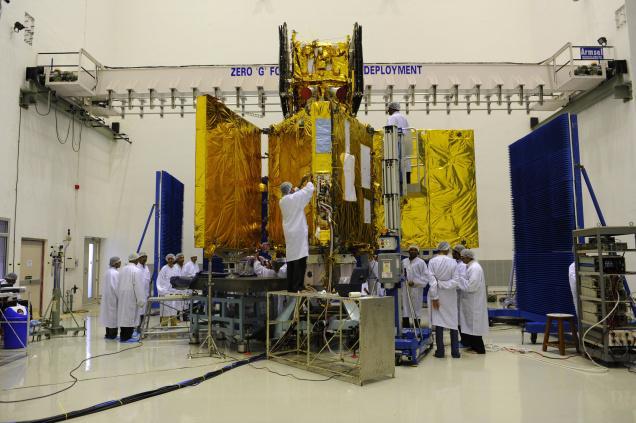April 23, 2012
CHENNAI: The countdown for the Thursday early morning launch of a rocket laden with remote sensing satellite Risat-1 has begun in Sriharikota in Andhra Pradesh, an ISRO official said, a step that will reinforce India's global leadership position in the field.

April 23, 2012
CHENNAI: The countdown for the Thursday early morning launch of a rocket laden with remote sensing satellite Risat-1 has begun in Sriharikota in Andhra Pradesh, an ISRO official said, a step that will reinforce India's global leadership position in the field.

RISAT-1 undergoing prelaunch tests in the clean room at the Satish Dhawan Space Centre in Sriharikota.
Photo Courtesy : ISRO
The indigenous Radar Imaging Satellite (Risat-1) would be used for disaster prediction and agriculture forestry, and the high resolution pictures and microwave imaging could also be used for defence purposes, a statement from Indian Space Reseacrh Organisation (ISRO) said.
Polar Satellite Launch Vehicle (PSLV) is all set on the launch pad at Sriharikota, 80-km from here, to blast off at 5.47 am on April 26 ferrying the 1,858 kg Risat-1, a wholly Indian-built spy/surveillance satellite.
"The countdown for the Thursday launch started at 6.47 a.m Monday. The filling up of the propellant (2.5 tonne) for the fourth stage/engine is progressing smoothly. The same propellant but in small quantities (600 kg) will also be filled for the powering the rocket control systems," an ISRO official preferring anonymity told IANS.
Remote sensing satellites send back pictures and other data for use. India has the largest constellation of remote sensing satellites in the world providing imagery in a variety of spatial resolutions, from more than a metre ranging up to 500 metres, and is a major player in vending such data in the global market. With 11 remote sensing/earth observation satellites orbiting in the space, India is a world leader in the remote sensing data market. The 11 satellites are TES, Resourcesat 1, Cartosat 1, 2, 2A and 2B, IMS 1, Risat-2, Oceansat 2, Resourcesat-2, Megha-Tropiques.
The satellite's synthetic aperture radar (SAR) can acquire data at C-band. In 2009, ISRO had launched 300 kg Risat-2 with an Israeli built SAR enabling earth observation on all weather, day and night conditions.
According to an ISRO official, Tuesday the rocket systems will be charged with gases and fuelling of the rocket's second stage with liquid propellant would happen.
Also, charging of batteries and pressurization of propellant tanks on-board the satellite will be performed. Readiness of various ground systems such as tracking radar systems and communication networks will also be checked.
The rocket would inject Risat-1 satellite into an orbit of 480 km altitude at an inclination of 97.552 degree. The satellite will be put in its final orbital configuration at 536 km altitude using thrusters onboard the satellite.
The rocket that would sling Risat-1 will be the four staged PSLV's upgraded variant called PSLV-XL which would weigh 320 tonnes at lift-off. The PSLV's four stages are fuelled with solid and liquid propellants. The first and third stages are fuelled by solid fuel while the second and fourth stages are powered by liquid fuel.
ISRO had used the PSLV-XL variant (rocket with extended strap-on motors than what the base model has) for its moon mission (Chandrayaan-1) in 2008 and for launching its communication satellite GSAT-12 in 2011.
According to ISRO officials the rocket launch will be controlled by space scientists at the new mission control centre inaugurated by President Pratibha Patil this January.
The new mission control centre is modern and has larger area to accommodate more space scientists, officials, VIPs and others.
Courtesy: TOI
















































































































